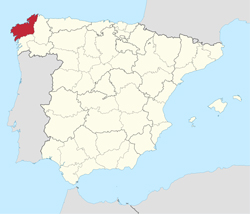La Coruña in La Coruña

The Province of La Coruña (‘A Coruña’ being the Galician and official name) is the most Northwestern Atlantic facing province of Spain, and one of the four provinces which constitute the autonomous community of Galicia.This province is surrounded by the Atlantic Ocean to the West and North, Pontevedra Province to the South and the Lugo Province to the East.
La Coruña’s climate is not what is normally associated with Spain with its mild temperatures and all-year-round rainfall. Although the rain is no longer quite as regular as it used to be, and over the last few years drought has been known to occur on occasions.
 La Coruña is not a very mountainous province, and its highest point is Pico de Pilar at 803m above sea level. As is logical with its rainy, mild climate, it is a very green province with lots of pastures and the second highest cow population of any Spanish province (León is the no. 1).
La Coruña is not a very mountainous province, and its highest point is Pico de Pilar at 803m above sea level. As is logical with its rainy, mild climate, it is a very green province with lots of pastures and the second highest cow population of any Spanish province (León is the no. 1).
The human population of La Coruña amounts to 1,123,000. Of these, 244,099 (2017) reside in the capital of the same name.
The city of La Coruña is set on the edge of the Atlantic Ocean, and its centre is on a peninsula connected to the main land by a narrow strip of land and it has two separate marine faces: The port overlooking the La Coruña Estuary, and the beaches which look out to the open sea around the inlet of Orzán.
La Coruña has been an important port since time immemorial, and it is home to the world’s oldest working lighthouse, and the only Roman one still working, the 57m tall Tower of Hercules, which dates back to the 1st century AD and is one of A Coruña’s most visited tourist attractions.
The Romans dominated La Coruña until, as in so many other parts of Spain, the Visigoths arrived and ousted them from this small town whose only real importance was its port.
When the Moors arrived on the Peninsula centuries later this was hardly noticed in this north-western corner, and La Coruña was incorporated into the Christian Kingdom of Asturias less than a hundred years later.
La Coruña port maintained its importance over the centuries, and the city’s economy reached an unprecedented strength when Alfonso 10th granted it exclusivity with no taxes payable on the unloading and selling of salt. A couple of centuries later, when the port of Cádiz lost its patent on commerce with the New World, A Coruña’s economy greatly benefitted once again..
However, during the wars of the 16th and 17th centuries general decline settled in the city due to taxes being levied to finance the army and the young able-bodied men were conscripted.
The ill-fated ‘Armada Invencible’, known in English as the Spanish Armada, sailed out from La Coruña on 21st July 1588 with the aim of escorting an army from the Netherlands to England to remove Queen Elizabeth I from the throne.
As we all know, a mixture of bad strategies and terrible storms put paid to the plans, and of the 130 ships that left La Coruña, less than two thirds returned.
La Coruña’s importance as a port and city started growing again in the 20th century, and in spite of its staunch republican stance before the civil war (which was quashed early on), the city’s growth carried on steadily over the decades.
Today La Coruña is a modern city with a healthy economy mainly based on industry. One of the most important employers is the Repsol Refinery, which was constructed in 1964 and employs more than 1,000 people. Sadly, another side of that coin is the shipping disasters that have taken place off the coast over the years, repeatedly contaminating the coast and beaches, necessitating massive cleanup operations.


